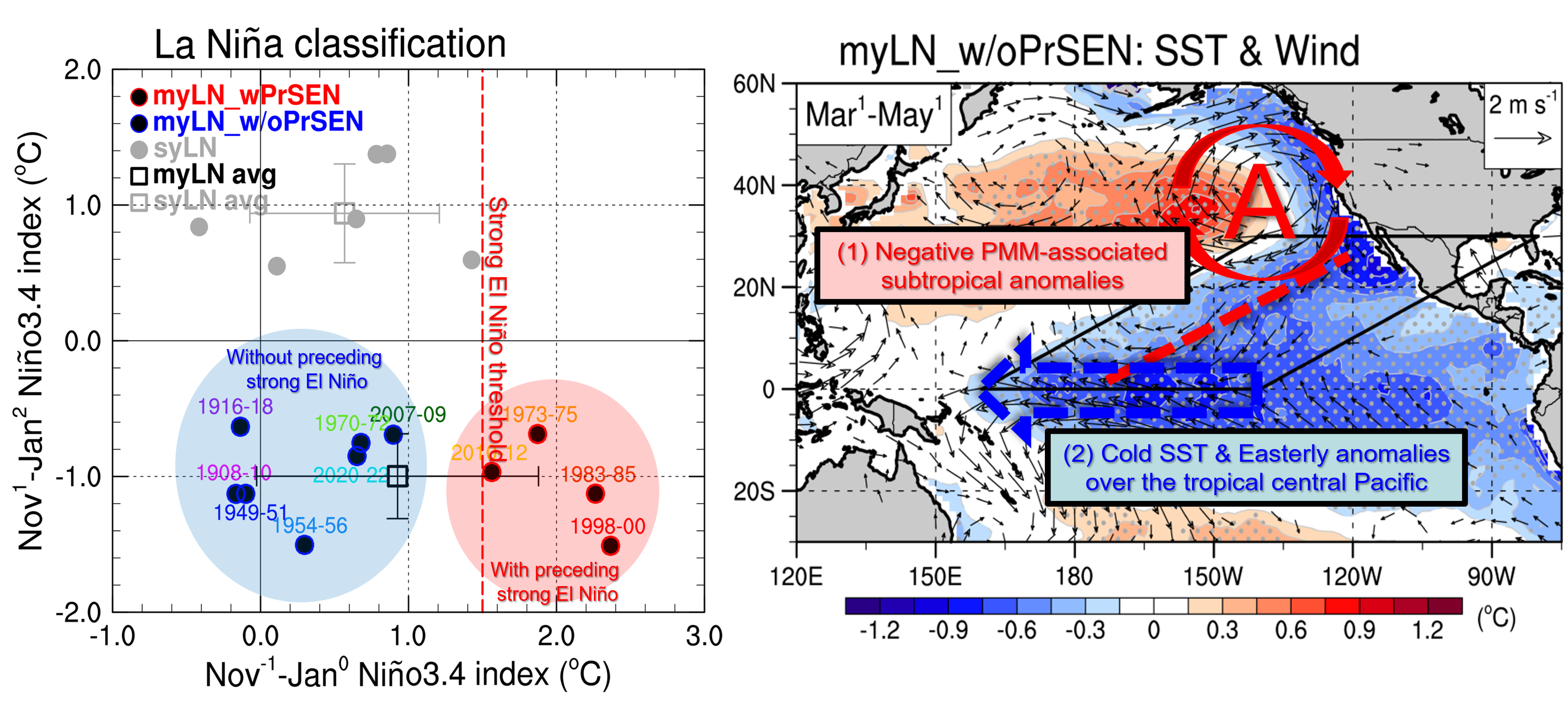Overemphasized role of preceding strong El Niño in generating multi-year La Niña events
Published in Earth & Environment

The El Niño/Southern Oscillation (ENSO) phenomenon, the most consequential year-to-year fluctuation of the Earth's climate system anchored in the tropical Pacific Ocean, profoundly influences global weather and climate patterns, ecosystems, and worldwide food production.
El Niño and La Niña events, the warm and cold phases of the ENSO, respectively, exhibit considerable inter-event differences with respect to their amplitudes, spatial structures, and temporal evolutions (known as complex ENSO behaviors) [1]. One of the complex ENSO behaviors arises from the diverse temporal evolutions, which can be characterized as transitional single-year or successive multi-year ENSO events. For example, some ENSO events rapidly decay after their peak and transition to the opposite phase in the following year, resulting in a transitional single-year event. Others, however, do not decay after their peak but linger or re-intensify in the following year, producing a successive multi-year event [2]. The multi-year event can be further divided into a lingering or re-intensified type according to its decaying evolution pattern [3]. Understanding the diverse ENSO evolution patterns and their underlying mechanisms has been a central topic for ENSO research in the past decade, as the ability to precisely predict whether an ENSO event will terminate shortly after one year or last two years or longer is of global importance.
Unlike most El Niño events, which typically have a short lifetime within a year, roughly more than half of La Niña events (43‒70%) persist for two years or longer, becoming a multi-year La Niña. There have also been increased occurrences of La Niña events that persist for multiple years since the 1990s, including not only double-dip La Niña (events that last two years) but also triple-dip La Niña (events that last three years), like the latest event that began in September 2020. Studies have shown that these multi-year La Niña events can be particularly impactful, as they exert more severe climate impacts or shifts in anomaly patterns than single-year La Niña events. For instance, they cause consecutive droughts in the southern United States during boreal winter [4], extreme warm temperatures over Korea and Japan during boreal summer [5,6] torrential rain and floods in eastern Australia during austral winter and spring [7], and pronounced zonal shifts in Antarctic sea ice concentration anomalies during austral winter [8]. Therefore, researchers have focused on gaining a better understanding of the dynamics that govern the temporal evolution of La Niña, with a greater emphasis on studying the mechanisms behind the formation of multi-year La Niña events.
The latest multi-year La Niña event, spanning from 2020 to 2022, has drawn significant attention from the climate research community. This is because, apart from being the first triple-dip event of the 21st century, the event was not preceded by a strong El Niño but by a very weak one, which contradicts traditional views emphasizing the significance of a preceding strong El Niño. This raises the following science question: Is a preceding strong El Niño required to generate multi-year La Niña events?
In this study, we analyze various observational data covering the 20th century (1900‒2022) and demonstrate that the role of preceding strong El Niño has been overemphasized, as the majority of multi-year La Niña events did not actually require a strong El Niño in the preceding year (events in the blue shaded circle as shown in Fig. 1; left). Instead, we identify that the mechanism associated with a negative North Pacific Meridional Mode (PMM) [9] following the first La Niña, which involves two-way interactions between tropical ENSO and subtropical PMM, plays a crucial role in these events (as shown in Fig. 1; right).

Our proposed mechanism, referred to as the PMM mechanism, can operate independently without the need for the existence of a preceding strong El Niño and is applicable not only to double-dip but also to triple-dip La Niña events. Consequently, it provides a comprehensive explanation for the generation of multi-year La Niña events, regardless of the El Niño conditions in their preceding years. Unlike most prior studies that considered PMM as merely a secondary adjustment to the primary oceanic discharge-recharge process associated with the preceding strong El Nino, we place direct emphasis on the subtropical ENSO dynamics linked to PMM as the foremost and crucial mechanism in generating multi-year La Niña events.
These findings of the study contribute significantly to advancing our understanding of ENSO dynamics. Furthermore, they bear substantial socio-economic relevance, particularly in light of the intense and prolonged climate impacts associated with multi-year La Niña events.
Follow the Topic
-
Nature Communications

An open access, multidisciplinary journal dedicated to publishing high-quality research in all areas of the biological, health, physical, chemical and Earth sciences.
Related Collections
With Collections, you can get published faster and increase your visibility.
Women's Health
Publishing Model: Hybrid
Deadline: Ongoing
Advances in neurodegenerative diseases
Publishing Model: Hybrid
Deadline: Dec 24, 2025

Please sign in or register for FREE
If you are a registered user on Research Communities by Springer Nature, please sign in